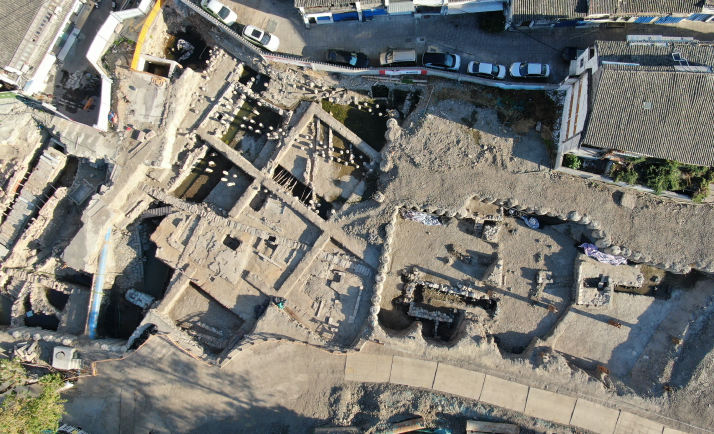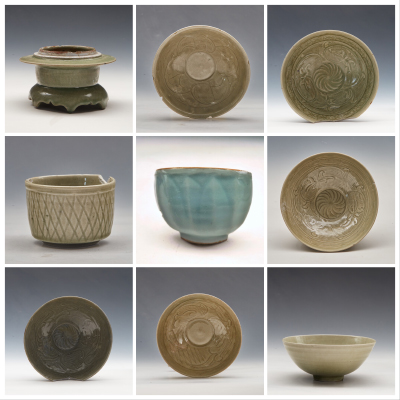Archaeological discovery brings ancient port city back to life

After more than a year of archaeological excavation, a site consisting of wengchengs (enclosures for defense usually outside city gates), docks and sunken ships has emerged. Located in modern-day Lucheng District, the port ruins are located outside Shuomen Gate, the north gate of the ancient city of Wenzhou. The site has therefore come to be known as the Shuomen Ancient Port.
The site was listed among the Top 10 New Archaeological Discoveries of 2022, announced by the National Cultural Heritage Administration on March 28. The annual list, first launched in 1990, is considered one of the most important honors that can be bestowed on an archaeological project in China.

Significance
The site was discovered in 2021, when archaeological fieldwork was conducted during the building of an underpass in Lucheng District.
While digging in the area, the construction crew unearthed a number of ancient stone bars at the site, indicating the possible presence of historical ruins in the vicinity. The construction project was then brought to a halt to make way for archaeological excavation, which was conducted by the Zhejiang Institute of Cultural Relics and Archaeology and the Wenzhou Institute of Cultural Relics and Archaeology (WICRA).
Archaeological work on the site began in October 2021 and ended late last year, after excavating an area of approximately 50,000 square meters.
"We found the cultural artifacts excavated from the site date from the Northern Song Dynasty (960-1127) to the Republic of China period (1912-49), including eight docks, two sunken ships and piles of porcelain fragments," Liang Yanhua, head of the WICRA, told Xinhua News Agency.
Wenzhou was first built in the Eastern Jin Dynasty (317-420) and had been called Dongou before it was renamed Wenzhou in 675 during the Tang Dynasty (618-907). Located on China's southeast coast, the city has more than 1,000 years of history as a port of foreign trade.
During the Song (960-1279) and Yuan (1279-1368) dynasties, the city became an important port city on the ancient Maritime Silk Road.
The ancient Maritime Silk Road was a conduit for trade and cultural exchange between China's southeastern coastal areas and countries in Southeast Asia, Africa and Europe. Silk, porcelain, tea, and brass and iron were the four main categories exported to foreign countries along the route; while spices, flowers and plants, and rare treasures for the imperial court were brought back to China.
It was from Wenzhou that Chinese diplomat Zhou Daguan sailed to Angkor, the capital of the Khmer Empire, in 1296, and wrote The Customs of Cambodia, detailing his observations of Khmer society over a one-year period. The Khmer Empire existed from approximately 802 to 1431 and ruled much of what is now Cambodia, Laos, Thailand and Viet Nam.
The discovery of the Shuomen Ancient Port recaptures the prosperity of Wenzhou as a commercial port in the Song and Yuan dynasties. Relics discovered at the site, as well as those discovered during the excavation of Wenzhou's ancient city from 2013 to 2015 and a pair of ancient lighthouses built in the Tang and Song dynasties on Jiangxin Islet, bring to life the busy port city that existed in ancient times.
Relics found at the port, including piles of porcelain pieces, suggest Wenzhou had been a main distribution center and the starting point for transporting Longquan celadon to other countries.
Longquan celadon porcelain is known for its elegant colors, especially jade green and light blue. One theory behind the origin of the name celadon is that it comes from Céladon, the name of one of the main characters in the 17th-century French novel L'Astrée, who was described in the novel as wearing pale green ribbons.
From the Southern Song Dynasty (1127-1279) to the middle of the Ming Dynasty (1368-1644), the main type of porcelain exported from China was Longquan celadon. The golden era of Longquan celadon was in the Southern Song Dynasty and the following Yuan Dynasty, when there were more than 300 kilns in Longquan City, in today's Zhejiang.
As Longquan and Wenzhou were connected by the Oujiang River, it was most convenient for Longquan celadon to be exported from Wenzhou, Shen Yueming, a professor of the Department of Cultural Heritage and Museology at Shanghai's Fudan University, told Xinhua.
The site is regarded as the most important ancient port discovered along the ancient Maritime Silk Road. In China, many port cities such as Quanzhou in Fujian Province and Guangzhou in Guangdong Province lack archaeological evidence to support their claims of having been port cities along the ancient Maritime Silk Road. The Shuomen Port site therefore offers valuable new insight into the ports of the era. Liu Qingzhu, former Director of the Institute of Archaeology of the Chinese Academy of Social Sciences, told Xinhua the port site is the most complete of its kind found in China. The relics and artifacts at the site, which can be accurately dated, provide solid evidence that the Maritime Silk Road thrived during the Song and Yuan dynasties.
Reviving an ancient port
More attention has been paid to the ancient Maritime Silk Road after China proposed the building of a 21st-Century Maritime Silk Road to revive and extend its ancient counterpart. Archaeological discoveries related to the ancient Maritime Silk Road have also been increasing in recent years. One of the other new discoveries is the Fancunjing Relic Site, in Taicang, a port city of Jiangsu Province, which was discovered in 2016. Tons of porcelain artifacts dating back to the late Yuan Dynasty have been discovered at the site, suggesting it was an official trade center at the time. In 2021, the port city of Quanzhou won UNESCO World Cultural Heritage status as a cultural property. The property includes 22 sites of administrative buildings and structures, religious buildings, and statues. The discovery of the Shuomen port site has provided new material for research related to the ancient Maritime Silk Road, Wang Wei, Chairman of the China Archaeology Society, told Xinhua. Wenzhou's government plans to build an indoor and outdoor facility dedicated to the preservation and display of the site's artifacts to ensure the ancient port lives on for centuries to come.
Related articles
-
 Pottery Storyteller Beating a Drum: life-long singing
Pottery Storyteller Beating a Drum: life-long singingMore
-
 Fortifying history, beyond bulwarks
Fortifying history, beyond bulwarksMore
-
 Inlaid Turquoise Bronze Plaque
Inlaid Turquoise Bronze PlaqueMore
-
 Cultural Relic: Square Ding with Nipple Design
Cultural Relic: Square Ding with Nipple DesignMore
-
 Archaeological discovery brings ancient port city back to life
Archaeological discovery brings ancient port city back to lifeMore
-
 Secrets emerge in Northwest China from the mists of time
Secrets emerge in Northwest China from the mists of timeMore
